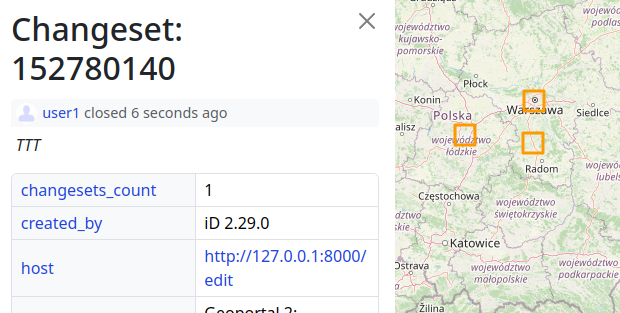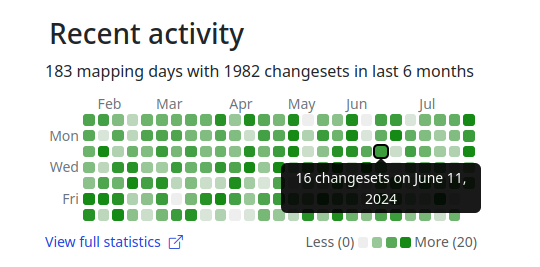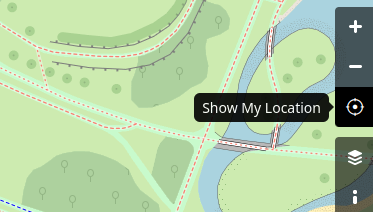Getting to know OpenStreetMap (OSM)
I love maps. Since I was a kid, I was fascinated by the old atlases and maps I found in my grandfather’s drawers. I could spend hours learning about countries’ borders, historic events, and the world through those thematic and topographic pieces of art and science.
Circumstances had it that eventually I ended up with a Masters Degree in Geography, unleashed onto the professional world, trying to make some positive contributions, some might say, “to change the world”, on the beautiful island of Lombok, Indonesia.
I still remember, when back in 2008, my colleague showed me an article about a crazy project to make a free map of the world, basically by using GPS tracks as the main data source – high resolution satellite imagery as we know it now, was not yet accessible. Crazy idea, impossible, overambitious, were a few thoughts that popped up. Though, “why not give it a try” and add a few roads and places in my neighborhood. I don’t think those few edits made a big difference to OSM – but it thought me of how to use and contribute to OSM.
Becoming an OSM contributor
The following year I ended up living and working in the town of Putussibau, Kapus Hulu District. Take a dart, throw it somewhere onto the middle of a map of Borneo, the biggest Island in Indonesia, and if you slightly missed the exact middle a little bit to the north-west - that’s where I found myself. Surrounded by amazing nature, amid local Dayak, Iban, Punan and Malayu as well as other Indonesians who had moved there more recently from other parts of the archipelago, I was teaching GIS and conservation, mapping forests, customary boundaries and the manifestations of an increasing human footprint there – road infrastructure, oil palm plantations, gold mining areas and the like.
While my maps slowly filled up with data of villages, roads, rivers, online maps such as Bing and Google had very little to say about Putussibau and Kapus Hulu, mostly just showing a huge expanse of – “empty, nothing”.
Here is where my OSM journey really started. I figured out how I could include my data into OSM, started to digitize more rivers, roads and when I left two years later OpenStreetMap had probably the best publicly available map data for Putussibau Town and many other areas in Kapuas Hulu. Somehow it felt good to put “a place onto the map”, to be able to fill some void.
The idea of OSM, to create a free map of the world suddenly did not sound so crazy anymore – I realized that if many people collaborate with a common goal, the seemingly impossible is suddenly within reach.
The value of collaboration and community
Back on Lombok, I started to share my OSM experiences, encouraged and helped others to also share their data with the OSM community and continued to map here and there. It was very helpful that at the same time Microsoft started to allow the use of their Bing satellite imagery to trace features for OSM – as it made contributing to OSM much easier and allowed to also excite non-Geographers or mapping people to become part of the OSM community.
OSM also became a good way to start teaching about mapping and GIS and give students the feeling that after a relatively short training, they could already create something useful – not just some training exercise data, to be discarded afterwards as in my previous mapping trainings.
While working on Lombok Island and the province on East Nusa Tenggara I met with people from the Humanitarian OpenStreetMap Team (HOT), who were supporting projects, focusing on rural development in eastern Indonesia and disaster risk reduction in Jakarta through training mappers, supporting mapping missions and developing tools and leveraging the OSM ecosystem.
As a self-taught hobby OSM’ler this was exciting and I was lucky enough to find ways to become more deeply involved in some of their and their partners’ project activities, gaining a much better insight of OSM, see how OSM can be used by government agencies, communities and others to really make a change and also experience some of the many challenges, meeting inspiring people and making new friends.
What I also like about OSM is that while easy and simple to contribute and use, below the hood, it is nevertheless a complex system of data infrastructure, mapping and data access tools, evolving mapping standards & best practices and last but not least, it’s a community of like-minded people each with their own strengths but sharing the common interest for free and open data and mapping. There is always something new to learn. Engaging with OSM taught me a lot and pushed me to expand my understanding of GIS and working with data and within a community.
Making and impact through sharing data with OSM
When I eventually left Indonesia for Myanmar, I made sure I was able to share as much relevant data as possible from my work with OSM, e.g. adding a wealth of thoroughly mapped roads and points of interest for Mataram, Lombok’s biggest city, and parts of north-western Lombok. And if you find yourself sipping a cocktail at a beach bar on the (in)famous Gili Trawangan Island, keep an eye on the street signs. You’ll likely see roads named after local sealife—names created, agreed on and made official by the local community, with assistance from Gili Ecotrust and partners, using OSM data and derived maps.
Very often, so-called development projects go to great efforts to create a lot of quality geospatial data. Unfortunately, very often, at the end of those projects those data disappear in data archives accessible to only a few, are forgotten or lost entirely. With a little extra effort, some of those data could (and should) be made available to the public. It would be effort well spend to filter out sensitive data, remove less relevant project specific data, document and transform the remaining data and share those with OSM or other open data platforms.
OSM in Myanmar
I was fortunate to arrive in Myanmar at a time when the country’s fortunes seemed to finally be heading in the right direction. Astonishing reforms were initiated, bringing a new sense of development, openness and democracy, and improving the prospects of the country and the lives of millions.
With people just starting to get access to internet, there was obviously no vibrant Myanmar OSM community yet, nor did many people use (or know how to make use of) maps anyway. Nevertheless, things changed when internet became more and more affordable and with the likes of Grab “forcing” people, or at least the cab-drivers, to use maps. Organizations and individuals increasingly mapping in and using OSM.
Working initially for a conservation NGO in the country, I experienced first-hand the scarcity of quality large scale geospatial data. MIMU, a UN organization did and still does a great job trying to provide medium and small scale geospatial data, but if you are looking for geodata to make maps and conduct analysis on anything going beyond township level scale, the only options you had was illegally using topographic map scans “leaked” from a military affiliated government department or outdated topographic maps produced by the colonial government a century ago. For large scale map data, suitable to make maps on village tract or site level, you were completely on you own.
When, after some years, changing jobs to working on a project with a strong focus on geospatial data with the Centre for Development and Environment (CDE), new opportunities to more strongly reengage with OSM opened.
CDE jointly with Fauna & Flora International (FFI) translated essential OSM training materials from learnOSM, the Official HOT OSM learning materials into Myanmar https://learnosm.org/my and we provided funding and technical assistance to Phandeeyar, a Yangon based technology seed accelerator to organize and support the emerging Myanmar OSM and open data community. Furthermore, I was able to provide numerous OSM beginner trainings in Yangon, the largest city in Myanmar, and in the coastal city of Dawei, which became my home for several years.
It was always exciting to see how many OSM beginners enthusiastically mapped their home villages and areas they had a personal connection to. Some of them continued to contribute by mapping large areas to the extent that I wondered where they even found the time to do so.
I believe that contributing to OSM is most effective when organized as a community with clear goals in mind. A collaboration between the Red Cross, Missing Maps, CDE, and Phandeeyar to map the city of Mawlamyine in 2018 is a perfect example. https://www.missingmaps.org/blog/2018/09/24/mapping-in-myanmar/
OSM in the face of Myanmar’s new realities
Tragically, Myanmar’s path to progress was abruptly halted. Following the military takeover in February 2021, the country has largely descended into crisis, chaos, and conflict. Poverty has risen sharply, security has severely deteriorated, political freedoms have been significantly reduced, and armed conflict taking place in many parts of the country.
Many, especially young people, have either left the country or joined the resistance. The space for open dialogue has diminished, making ends meet becoming a daily challenge and in the face of reality, the once-ubiquitous smiles of the Myanmar people are becoming increasingly rare. In light of this dire situation, the once-active Myanmar OSM community had largely disintegrated.
Civil society, humanitarian organizations and passionate individuals are trying to provide basic assistance to the most vulnerable people in Myanmar. Having access to reliable maps can help them to be more effective. If access to geospatial data was challenging during Myanmar’s better years, it has only worsened since. While google maps for Myanmar has improved significantly over the last decade and is used widely, its terms-of-use and access limitations severely limit its usability, not to mention the lack of detail and coverage, esp. in rural areas.
I believe that OSM, as the best available open mapping platform offering detailed large-scale geospatial data, becomes even more valuable in such circumstances. As such me and my organization is working to re-activate the Myanmar OSM community, support Myanmar OSM mappers, and collaborate with HOT, e.g. to provide technical assistance and facilitate remote mappers to help improve essential OSM data for Myanmar.
MyOSM, our Myanmar OSM group, has since grown in numbers and skills and it is amazing how much myOSM has already been able to map, improving data on settlement areas, roads, rivers and other features that can be mapped remotely – field mapping for security reasons is currently highly restricted.
HOT’s Open Mapping Hub - Asia Pacific (AP Hub) Guru Fellowship program was instrumental as it provided four myOSM members essential skills for OSM focused training, mapping and validation. Furthermore, joining the 5 months fellowship program fostered a sense of community and belonging to an international group helping each other and joining hands to improve OSM. Equipped with the new skills, we are more confident in our OSM activities and can better share those skills with and help other OSM mappers.
Expanding to Lao PDR
My journey with OSM is far from over.
Currently, I am based in Vientiane, the capital of Lao PDR. Access to large scale geospatial data is also a challenge in Laos and unfortunately there is no strong Lao-OSM community yet – with most OSM mapping here done by individuals, mostly foreigners. Though our OSM-Laos group is trying to change this by organizing trainings, outreach activities and smaller mapping missions.
In my case, I helped with a OSM beginner training at the Department of Geography, National University of Lao and organizing a Mappy Hours Event – a mapping meetup for OSM mappers in Vientiane.
Building an active community here may seem challenging, but so did the idea of creating a free map of the world back in the mid-2000s. If we believe in our goals and work together, nothing is impossible.
Happy mapping, everyone!
Location:







